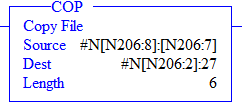Divisibility31
Member
Hello,
I'm very new to programming with absolutely zero schooling in this field and pretty hands off training in my new role, it's been fun (sarcasm intended). I've had to try learning everything on the fly. So as you answer this, I'd love dumbed down answers if possible =P.
Anyway, I had to convert a RSLogix5 program to RSLogix5000 and most things converted fairly well, except for anything with indirect addressing and specifically the things like the examples attached. I can't wrap my head around how to make this work and after days of trying to study up on finding a solution and watching many youtube videos, I find myself here. Thanks in advance for your time and assistance (and patience that will likely be needed to deal with a newbie like me).




I'm very new to programming with absolutely zero schooling in this field and pretty hands off training in my new role, it's been fun (sarcasm intended). I've had to try learning everything on the fly. So as you answer this, I'd love dumbed down answers if possible =P.
Anyway, I had to convert a RSLogix5 program to RSLogix5000 and most things converted fairly well, except for anything with indirect addressing and specifically the things like the examples attached. I can't wrap my head around how to make this work and after days of trying to study up on finding a solution and watching many youtube videos, I find myself here. Thanks in advance for your time and assistance (and patience that will likely be needed to deal with a newbie like me).






